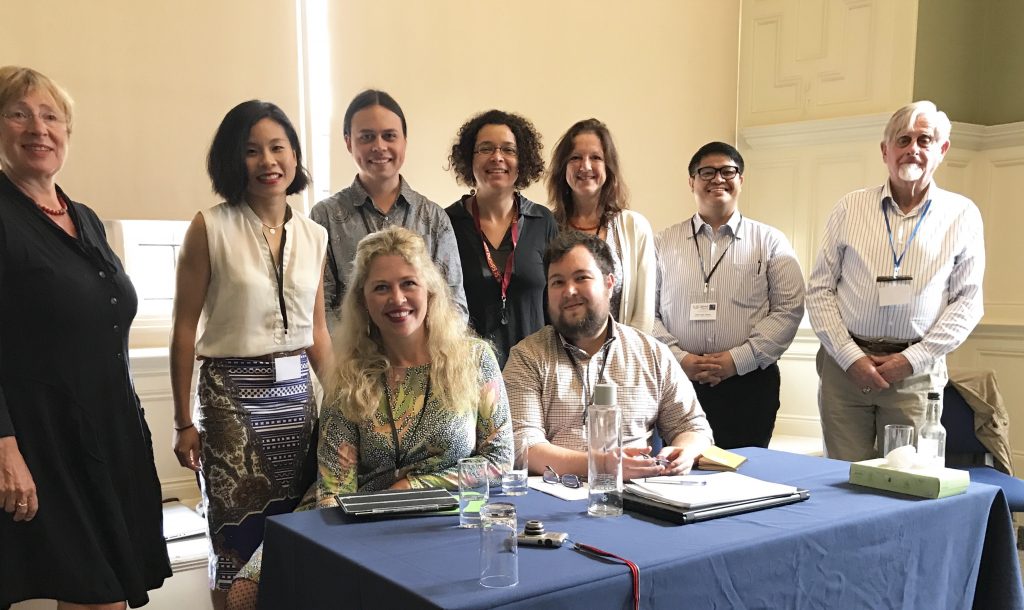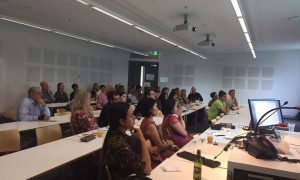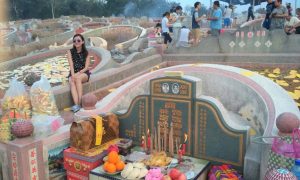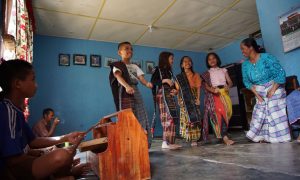Although we PoP members all share a general interest in Southeast Asian history/ies, we approach our research from very different perspectives – Nien as a performance studies specialist, Michael as an archaeologist, Natali as a museum and heritage studies scholar and Jarrah as a textual historian. Despite our shared passion for the study of the past, it is surprisingly difficult to find a common thread that unites us all. Perhaps this is what keeps our debates and discussions so vibrant.

Left to right: Jarrah Sastrawan, Michael Leadbetter, Natali Pearson and Cheng Nien Yuan
It was, therefore, quite a revelation to find a theme that united our research so neatly: the concept of ritual in the Southeast Asian context, on which we were invited to speak as part of a special lecture series organised by The Asian Arts Society of Australia (TAASA) this May. Other presenters in this series have included Emeritus Professor Peter Worsley (The depiction of ritual in Balinese painting of the nineteenth and early twentieth centuries), Dr Marnie Feneley (The Diamond Vajra – thoughts on a 12th century Khmer sculpture), and Dr Siobhan Campbell (Keeping Up with the Jeros: Made Wijaya and Balinese Ritual).
It was a privilege for us, as postgraduate students, to be invited to join these more established scholars in this forum, as well as a great opportunity for us to showcase our work to a different audience from the usual university crowd.

Michael Leadbetter in conversation with Indonesia specialist Toni Pollard at the TAASA lecture series, 1 May 2017. Photo: Sandy Watson
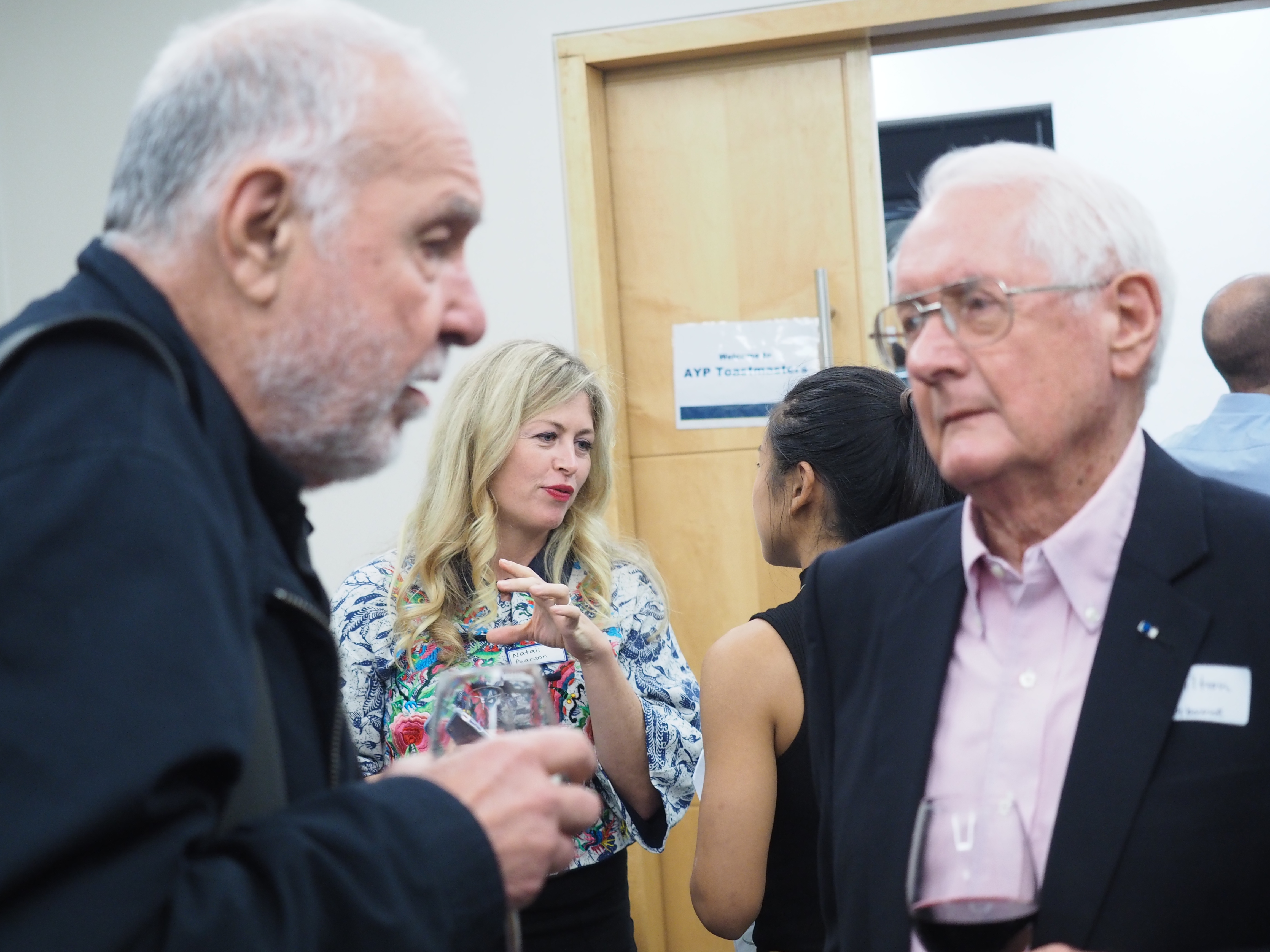
Left to right: India expert Dr Jim Masselos, PoP members Natali Pearson and Cheng Nien Yuan, and Southeast Asian historian Dr Milton Osborne, at the TAASA lecture series, 1 May 2017. Photo: Sandy Watson

Josefa Green, editor of TAASA Review (far left) and Dr Jackie Menzies, TAASA President and Emeritus Curator of Asian Art, Art Gallery of NSW (far right). Photo: Sandy Watson
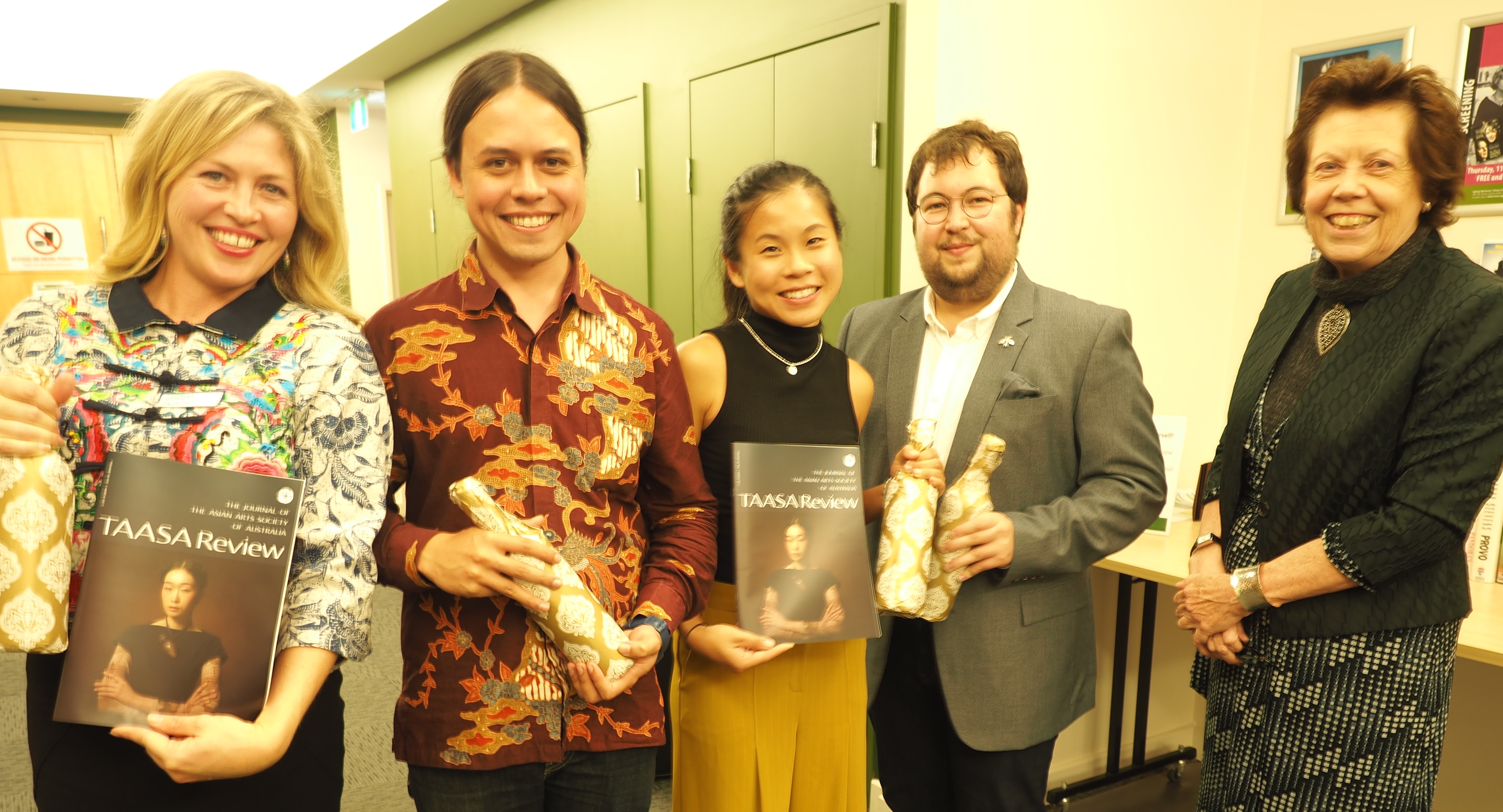
PoP with TAASA President Jackie Menzies, 1 May 2017. Photo: PoP
The process of preparing for and delivering our four mini TAASA lectures prompted us to revisit and re-interrogate our research as it related to ritual. In fact, so inspired were we by TAASA’s ‘Ritual in Southeast Asia’ theme that we decided to submit a panel proposal for the forthcoming (16-18 August 2017) European Association for Southeast Asian Studies (EuroSEAS) conference at the University of Oxford. This conference, now in its ninth iteration, attracts hundreds of specialists on Southeast Asia from all over the world.
Building on our TAASA presentations, our EuroSEAS proposal sought to bring together a wide diversity of perspectives to consider and critique ritual and the past in Southeast Asia.
We wanted to consider ritual broadly – as heritage, practice, performance, tradition, religion and spiritual practice. We also wanted to think about ritual in innovative ways – ritual as a subject of historical enquiry, ritual as a set of economic relationships, ritual landscapes and spaces, ritual connecting past and present, and ritual as heritage production.
Our proposal was accepted and was also expanded to a double panel, which meant that we had room for an additional four scholars. Thus it is that we find ourselves gathering in Oxford next week, with the generous support of the University of Sydney’s Sydney Southeast Asia Centre (SSEAC), to deliver a double panel on ritual in Southeast Asia. Professor Michele Ford from SSEAC is convening the panels, and Emeritus Professor Peter Worsley will act as our discussant.
PoP’s panels are scheduled for the first session of the first day of the EuroSEAS conference – panel one kicks off the discussion at 9am, followed by panel two at 11am. For more information, check out our speakers and abstracts below. We hope to see you there! And just a heads-up – PoP will be speaking at next year’s Asian Studies Association of Australia conference (3-5 July 2018) at the University of Sydney. Don’t miss it.
***
Panel One – 9am, Wednesday 16 August
- Lene PEDERSEN (Central Washington University)
Re-Envisioning the Theatre State: Land, Ritual and Polity in Bali
In 1980 Clifford Geertz proposed a provocative theory of the precolonial Balinese state as a “theatre state,” one in which power derived from a form of feudalism based not on land relations, but on ritual. Geertz’s thesis has been much criticized; Tambiah called it a “peculiarly disconnected” situation, and contemporary scholars often dismiss it altogether. Alternative analyses of the indigenous polity have been offered, but they typically end in an impasse of debate, where the dominant views—ritual spectacle and relationships versus emphasis on land connections and active governance—continue to be posed as contradictions. Yet these disconnects between symbolic and material sources of power coincide poorly with the results of my research, which indicate that they inter-relate.
Based on systematic mapping into a Geographic Information System (GIS) combined with extensive ethnographic interview data in a former Balinese princedom, now a bureaucratic district within the Indonesian nation, this presentation revisits the issue of land in relation to what Geertz described as a “theatre state.” It centers on the role of precolonial feudal land categories, still present in the landscape, and their relationship to ritual and power in the polity, to bring new evidence to bear on the longstanding debates surrounding materialist and symbolic forms of power, as well as contemporary questions regarding the role of traditional structures within the modern nation state. Although we will never be able to construct a complete picture of the role of land in the theatre state, re-membering these identities, re-calling them in order to map them, helps us to re-imagine the polity.
I suggest that the “theatre state” emerges from a nexus of the material and the symbolic, between the land and its produce and the relationships and rituals that this instantiates and generates. I also suggest that it does so from rituals at every level, not just the large post-mortuary rituals that most emphasize status and drew Geertz’s attention. To explore new ways of thinking about the theatre state, based on ritual at multiple scales, we used GIS generated kernel density estimates to visualize the realm in terms of ritual density. Re-envisioning the theatre state may in turn help us better understand the contemporary situation, for much as places like early Bali did not conform to western ideas of territorially-based or unified state power, they now often confound expectations of progress toward modernization and democratization when they do not neatly leave behind “irrational” practices and “feudal” relationships.
- Wayan Jarrah SASTRAWAN (University of Sydney)
Rituals of Dynastic Power in Ancient Java
From the early thirteenth to the late fifteenth century, much of Java and the Indonesian archipelago was dominated by a royal dynasty called Girindra (‘Lords of the Mountain’). From their power base in East Java, the Girindra kings and queens were great patrons of literature and art, leaving as their most impressive legacy a vast network of ancestral temples throughout their realm. In this paper I describe rituals by which dynastic leaders were deified and enshrined in these temples, in order that they could continue to safeguard their descendants’ power over the country. I argue that the spatial distribution of the ancestral temples forms a topogeny, where the geography of East Java can be mapped out in terms of a ritual network. Drawing on literary, epigraphical and archaeological sources, I show how the ritual project of the Girindra dynasty was intertwined with their reshaping of the political and economic landscape of East Java. The success and longevity of the Girindra dynasty had a profound cultural impact on the later Islamic kingdoms in the region, and plays a major role in Indonesian nationalism to the present day.
- Michael LEADBETTER (University of Sydney)
Beyond the Faces in the Jungle: the social and environmental cost of ritual
It has been claimed that humans are ‘the ritual animal’. Rituals are not inert expressions or reflections of humanity, ritual connects and interact with a variety of social elements. Rituals are a powerful force that constructs the human world. The consequences of ritual as a charged process extends beyond a brief and fleeting encounter that may take place during a spiritual act. Rituals have agency which act upon human society. Rituals have their own impacts independent of human intent. Rituals have significant ecological, social, and economic effects. They may compliment and serve the interests of a society, but may also run counter to humanities interests.
The ritual and temple landscapes of Southeast Asia, such as Angkor are some of the most recognisable archaeological and architectural sites on the planet. My research is informed by the archaeology and material anthropology of ritual landscapes in Southeast Asia. We know a lot about the meaning of these temples, but very little is known about the lives of the people who built and lived in these ritual landscapes. When we visit these great monuments, our focus is often on royals, deities and demons. How did the people who created and lived within these ritual landscapes live? What role did ritual systems and the changing ecology play in their lives and the continued and living history of these sacred places?
- Kelly SILVA (Universidade de Brasília)
Managing resources, people and rituals. Economic pedagogy as governance tactic in Timor-Leste
This paper addresses current attempts to manage people, resources and ritual practices by governance agencies in Timor-Leste. Based on the analysis of the tara bandu carried out in Ermera in 2012 and official propaganda, interviews and other documents produced in between 2012 and 2015, I argue how certain rationale about the disposal of material resources, oriented by the gift regime in ritual contexts has come to be a matter of government concern. It gives origin to an economic pedagogy which intends to turn into commodities resources managed primarily as gifts. In addition, such economic pedagogy intents: i. to decrease the material and symbolic investments people make in rituals and alliance prestations; ii. To make people believe that only live persons have agency in the world. Ultimately, inscribed in such a pedagogy is the project to monopolise the sources of government, prestige and social reproduction via the state, its institutions and projects. One also proposes to consider such economic pedagogy as purification endeavor.
Panel Two – 11am, Wednesday 16 August
- Mark Iñigo M. TALLARA (National University of Singapore)
Chasing Miracles in Quiapo: Symbolism of Kalooban and the Religious Practices to Nuestro Padre Jesus Nazareno
This paper is about the popular devotion to Christ in the Philippines focusing on the religious practices to Nuestro Padre Jesus Nazareno or popularly known as the Black Christ Nazarene of Quiapo in Manila. Although the origin of the devotion in Quiapo is central to my arguments this paper also calls for more scholarly attention on the historical and cultural connections between the Philippines and Mexico, focusing on the legacies of the Manila Galleon highlighting the origins of popular religious practices particularly the devotion to Christ. In order to understand the religious practices in Quiapo, there is also a need to examine the symbolism that surrounds the devotee’s motivation particularly their loob (inner self) and kalooban (interior self), hence this paper focuses also on the ontological understanding of the devotee’s sarili (self). Furthermore, this study argues that: (1) the devotional practices in Quiapo have its roots in the traditional religious understanding of Filipinos; (2) they use the symbolism of loob and kalooban to account for their religious experience; and (3) as a form of panata (vow) and recognition for their utang na loob (debt of gratitude), devotees in return joining the procession to honour the Black Christ Nazarene. This analytical step is consistent with the hypothesis that a consideration to the devotion to Jesus Christ is crucial to the understanding of popular Catholicism in the Philippines.
- CHENG Nien Yuan (University of Sydney)
Re-tualising Brother Cane: Performance Art in Singapore
On New Years Day in Singapore, 1994, Josef Ng protested against the police entrapment of twelve men in an “anti-gay operation” in the form of a public performance entitled Brother Cane. The following backlash caused a restriction on the licensing and funding of ‘unscripted’ performance art in Singapore that would last for more than a decade. Yet, this performance remains and repeats in the years since, the shamanistic actions of Ng mythicised, ritualised re-actualised in the courtroom, in newspapers and Ph.D. dissertations, and in the body of performer Loo Zi Han when he re-enacted Brother Cane as part of the Singapore M1 Fringe Festival in 2011. Was Loo’s performance an act of faith that things have changed, or another protest? This paper explores such complex questions which arise from the re-actualisation of Ng’s (paradoxically) ‘original ritual’ about the nature of performance art in Singapore, where the state fashions art as much as the performers themselves.
- Gertrud HÜWELMEIER (Humboldt University, Berlin)
Trance Mediumship goes on stage – The Heritagization of Popular Religious Practices in Vietnam
This paper explores the recent staging of trance mediumship in some of Hanoi’s theaters. Considered superstitious by the communist government for many decades, the ritual of worshipping the Mother Goddesses gradually regained popularity in the course of the past twenty years. After the Socialist Republic of Vietnam submitted documents to the UNESCO in 2014, requesting the recognition of the Mother Goddess religion as Intangible Cultural Heritage (ICH), theater groups started performing trance rituals on stage. Based on ethnographic fieldwork among spirit mediums and their followers in urban Hanoi, this presentation argues that the heritagization of spirit mediumship and its reenactment on stage moves from one aesthetic register to another, thereby addressing the senses and affecting bodily experiences in different ways. By focusing on the relationship between heritage studies and the anthropology of religion, the paper contributes to recent debates on mediatization, remediation and spectacularization of popular religious practices.
- Natali PEARSON (University of Sydney)
On the shipwreck trail: Ritual visits to underwater heritage sites
The commodification of heritage has seen a boom in cultural tourism in recent decades. The popularity of thana, or dark, tourism attests to the increasing ritualisation of visitor experiences at sites and landscapes of loss. This trend has been exacerbated by greater mobility, as travel becomes more affordable to an increasing number of people. Heritage sites are now more visible and visited than ever before, with interventions by heritage authorities at such sites serving to ritualise and sanitise visitor behaviour and experiences at the same time as they seek to educate and engage. But what are the implications when such sites are underwater? In this paper, I will look at the challenges of submerged cultural resource management with a particular focus on human remains at underwater sites in Southeast Asia. The hidden nature of underwater graves limits access, and precludes ritual visits and heritage interventions, in the same manner as their terrestrial equivalents, prompting questions about the extent to which tourists, survivors and descendants, and local communities, can engage meaningfully with underwater heritage sites.
 Facebook
Facebook  Twitter
Twitter  Soundcloud
Soundcloud  Youtube
Youtube  Rss
Rss 